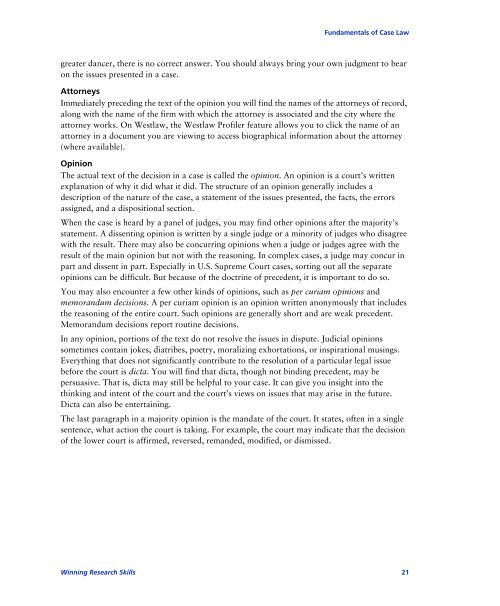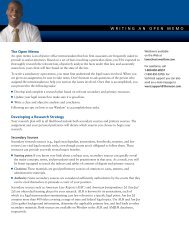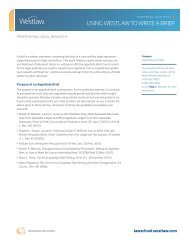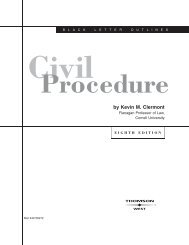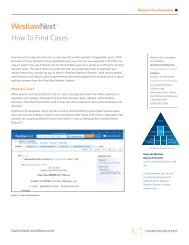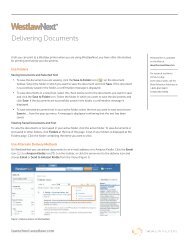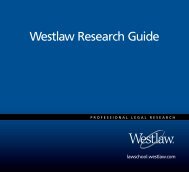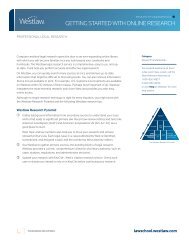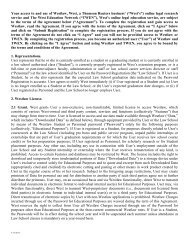Winning Research Skills - Westlaw
Winning Research Skills - Westlaw
Winning Research Skills - Westlaw
Create successful ePaper yourself
Turn your PDF publications into a flip-book with our unique Google optimized e-Paper software.
Fundamentals of Case Law<br />
greater dancer, there is no correct answer. You should always bring your own judgment to bear<br />
on the issues presented in a case.<br />
Attorneys<br />
Immediately preceding the text of the opinion you will find the names of the attorneys of record,<br />
along with the name of the firm with which the attorney is associated and the city where the<br />
attorney works. On <strong>Westlaw</strong>, the <strong>Westlaw</strong> Profiler feature allows you to click the name of an<br />
attorney in a document you are viewing to access biographical information about the attorney<br />
(where available).<br />
Opinion<br />
The actual text of the decision in a case is called the opinion. An opinion is a court’s written<br />
explanation of why it did what it did. The structure of an opinion generally includes a<br />
description of the nature of the case, a statement of the issues presented, the facts, the errors<br />
assigned, and a dispositional section.<br />
When the case is heard by a panel of judges, you may find other opinions after the majority’s<br />
statement. A dissenting opinion is written by a single judge or a minority of judges who disagree<br />
with the result. There may also be concurring opinions when a judge or judges agree with the<br />
result of the main opinion but not with the reasoning. In complex cases, a judge may concur in<br />
part and dissent in part. Especially in U.S. Supreme Court cases, sorting out all the separate<br />
opinions can be difficult. But because of the doctrine of precedent, it is important to do so.<br />
You may also encounter a few other kinds of opinions, such as per curiam opinions and<br />
memorandum decisions. A per curiam opinion is an opinion written anonymously that includes<br />
the reasoning of the entire court. Such opinions are generally short and are weak precedent.<br />
Memorandum decisions report routine decisions.<br />
In any opinion, portions of the text do not resolve the issues in dispute. Judicial opinions<br />
sometimes contain jokes, diatribes, poetry, moralizing exhortations, or inspirational musings.<br />
Everything that does not significantly contribute to the resolution of a particular legal issue<br />
before the court is dicta. You will find that dicta, though not binding precedent, may be<br />
persuasive. That is, dicta may still be helpful to your case. It can give you insight into the<br />
thinking and intent of the court and the court’s views on issues that may arise in the future.<br />
Dicta can also be entertaining.<br />
The last paragraph in a majority opinion is the mandate of the court. It states, often in a single<br />
sentence, what action the court is taking. For example, the court may indicate that the decision<br />
of the lower court is affirmed, reversed, remanded, modified, or dismissed.<br />
<strong>Winning</strong> <strong>Research</strong> <strong>Skills</strong> 21


